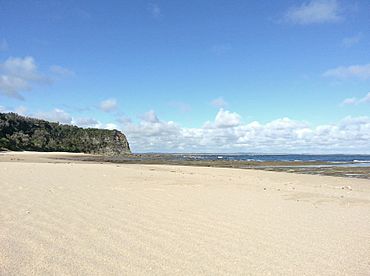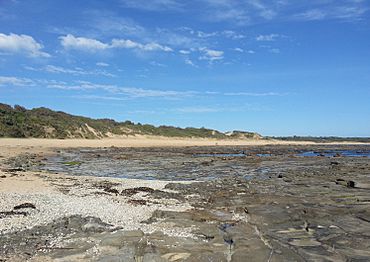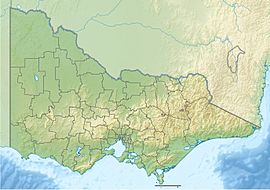Bunurong Marine and Coastal Park facts for kids
Quick facts for kids Bunurong Marine ParkVictoria |
|
|---|---|
|
IUCN Category VI (Managed Resource Protected Area)
|
|

The Caves Beach, near Eagles Nest in Inverloch.
|
|
| Nearest town or city | Cape Paterson |
| Established | 17 December 1991 |
| Area | 12.03 km2 (4.6 sq mi) |
| Visitation | circa 250,000 (in 2005) |
| Managing authorities | Parks Victoria |
| Website | Bunurong Marine Park |
| See also | Protected areas of Victoria |
| Bunurong Coastal Park Victoria |
|
|---|---|
|
IUCN Category III (Natural Monument)
|
|

Coal Point
|
|
| Nearest town or city | Cape Paterson |
| Established | June 1984 |
| Area | 92.9 km2 (35.9 sq mi) |
| Managing authorities | Parks Victoria |
| Website | Bunurong Coastal Park |
| See also | Protected areas of Victoria |
The Bunurong Marine and Coastal Park are two special areas. They protect the ocean and coastline near Harmers Haven, Cape Paterson, and Inverloch. These parks are in the South Gippsland region of Victoria, Australia. They are about 140 kilometres (87 mi) southeast of Melbourne. People visit them for walking, picnics, boating, learning, and research.
Contents
What are the Bunurong Parks?
The Bunurong Marine Park covers 1,203-hectare (2,970-acre) of ocean. It protects 12 kilometres (7.5 mi) of coastline. This park was officially created on December 17, 1991. Its wide rock platforms and underwater reefs are home to many different plants and animals.
The Bunurong Coastal Park is a narrow strip of land next to the Marine Park. It covers 93-hectare (230-acre). This park was created in June 1984. Both parks are named after the Australian Aboriginal Bunurong people. They are the traditional owners of this land and water.
Who are the Bunurong People?
The Bunurong parks get their name from the Bunurong Aboriginal people. They have lived along this coast for thousands of years. The Boakoolawal clan lived near Kilcunda. The Yowenjerre clan lived west of the Tarwin River. You can still find middens (old piles of shells and charcoal) along the coast. These show where their campsites used to be.
Exploring the Parks: Cool Features!
The parks have amazing rock formations. One famous one is called Eagles Nest. It looks like the top half of a map of Australia. You can find it at the eastern end of the marine national park.
Discovering Dinosaurs!
Did you know Australia's first dinosaur bone was found here? It was called the Cape Paterson Claw. William Ferguson discovered it in 1903 at Eagles Nest beach. Since then, over 6,000 bones and teeth have been found! These include small dinosaurs, mammals, birds, turtles, and fish. You can see a dinosaur exhibition at the Inverloch Shell Museum.
Fun Activities at the Parks
There are many fun things to do in the parks. At Flat Rocks, you can explore large rockpools. It's great for rockpool rambling. You can also go snorkelling and scuba diving to see underwater life.
A popular spot is near the Cape Paterson caravan park. It has a special rockpool for swimming. You can also launch boats at Inverloch on Anderson Inlet.
Amazing Marine Life
The Bunurong Marine and Coastal Parks are full of life. They protect many marine animals. You can find seastars, featherstars, crabs, and snails. There are also 87 different types of fish! Sometimes, you might even spot whales and seals. These parks have the most types of invertebrates (animals without backbones) in eastern Victoria. There are also many different kinds of seaweed.
Rules for Visiting
It's important to follow the rules to protect the parks. In the Bunurong Marine National Park, you cannot take anything. This means no catching fish, no collecting seashells, and no taking any creatures (living or dead). However, in the Bunurong Marine Park, you are allowed to fish with a rod.
Images for kids



